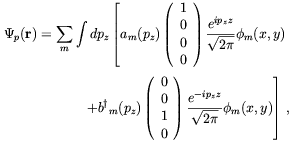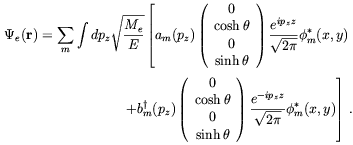


5.1.5. Proton Life Time
First we study the decay kinematics.
Combining Eq. (5.3), Eq. (5.14) and Eq. (5.26) we find the proton-neutron energy difference as a function of the applied magnetic field,

| (5.27) |
 decay for
B > 2.7 × 1014 T.
We shall now turn to a calculation of
the life time of the proton for fields satisfying the last inequality.
decay for
B > 2.7 × 1014 T.
We shall now turn to a calculation of
the life time of the proton for fields satisfying the last inequality.
With the wave functions of the various particles in the magnetic fields we may define field operators for these particles. For the proton and electron we shall restrict the summation over states to the lowest Landau levels with spin up, down respectively; for magnetic fields of interest the other states will not contribute to the calculation of decay properties. For the same reason, the neutron field will be restricted to spin down only. The proton and neutron kinematics will be taken as non-relativistic.

| (5.28) |
with  m(x,
y) defined in Eq. (5.5) and the energy,
Em(pz) in Eq.
(5.8). am(pz) is the annihilation
operator for a proton with momentum pzz and
angular momentum m;
bm(pz) is the same for the negative
energy states. For the neutron the field is
m(x,
y) defined in Eq. (5.5) and the energy,
Em(pz) in Eq.
(5.8). am(pz) is the annihilation
operator for a proton with momentum pzz and
angular momentum m;
bm(pz) is the same for the negative
energy states. For the neutron the field is

| (5.29) |
with an obvious definition of the annihilation operators. For the electron we use fully relativistic kinematics and the field is

| (5.30) |